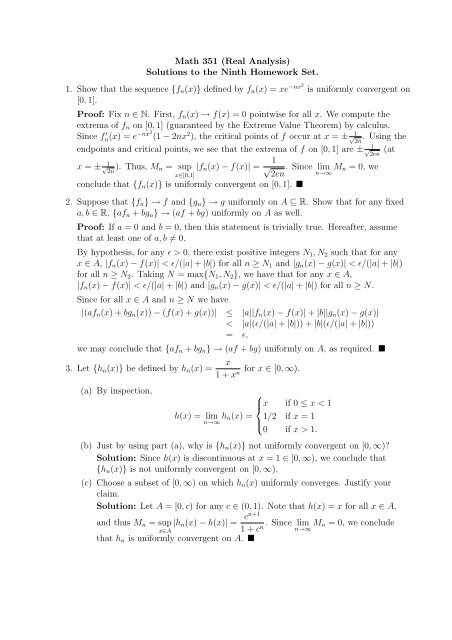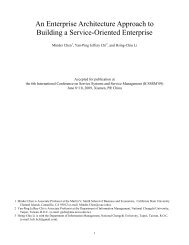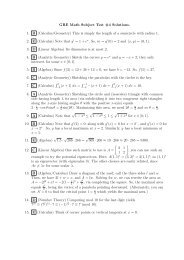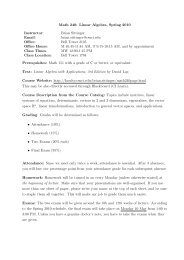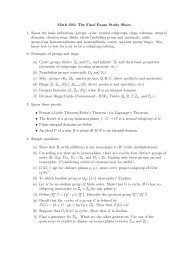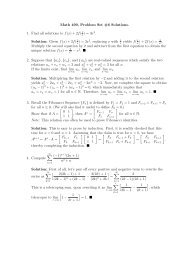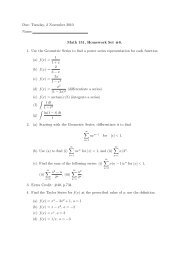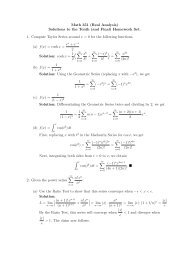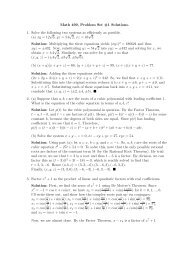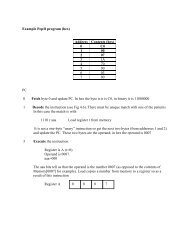Math 351 (Real Analysis) Solutions to the Ninth Homework Set. 1 ...
Math 351 (Real Analysis) Solutions to the Ninth Homework Set. 1 ...
Math 351 (Real Analysis) Solutions to the Ninth Homework Set. 1 ...
- No tags were found...
You also want an ePaper? Increase the reach of your titles
YUMPU automatically turns print PDFs into web optimized ePapers that Google loves.
<strong>Math</strong> <strong>351</strong> (<strong>Real</strong> <strong>Analysis</strong>)<strong>Solutions</strong> <strong>to</strong> <strong>the</strong> <strong>Ninth</strong> <strong>Homework</strong> <strong>Set</strong>.1. Show that <strong>the</strong> sequence {f n (x)} defined by f n (x) = xe −nx2 is uniformly convergent on[0, 1].Proof: Fix n ∈ N. First, f n (x) → f(x) = 0 pointwise for all x. We compute <strong>the</strong>extrema of f n on [0, 1] (guaranteed by <strong>the</strong> Extreme Value Theorem) by calculus.Since f n(x) ′ = e −nx2 (1 − 2nx 2 ), <strong>the</strong> critical points of f occur at x = ± √ 12n. Using <strong>the</strong>endpoints and critical points, we see that <strong>the</strong> extrema of f on [0, 1] are ± √ 12en(atx = ± √ 12n). Thus, M n = sup |f n (x) − f(x)| = √ 1 . Since lim M n = 0, wex∈[0,1]2en n→∞conclude that {f n (x)} is uniformly convergent on [0, 1]. 2. Suppose that {f n } → f and {g n } → g uniformly on A ⊆ R. Show that for any fixeda, b ∈ R, {af n + bg n } → (af + bg) uniformly on A as well.Proof: If a = 0 and b = 0, <strong>the</strong>n this statement is trivially true. Hereafter, assumethat at least one of a, b ≠ 0.By hypo<strong>the</strong>sis, for any ɛ > 0, <strong>the</strong>re exist positive integers N 1 , N 2 such that for anyx ∈ A, |f n (x) − f(x)| < ɛ/(|a| + |b|) for all n ≥ N 1 and |g n (x) − g(x)| < ɛ/(|a| + |b|)for all n ≥ N 2 . Taking N = max{N 1 , N 2 }, we have that for any x ∈ A,|f n (x) − f(x)| < ɛ/(|a| + |b|) and |g n (x) − g(x)| < ɛ/(|a| + |b|) for all n ≥ N.Since for all x ∈ A and n ≥ N we have|(af n (x) + bg n (x)) − (f(x) + g(x))| ≤ |a||f n (x) − f(x)| + |b||g n (x) − g(x)|< |a|(ɛ/(|a| + |b|)) + |b|(ɛ/(|a| + |b|))= ɛ,we may conclude that {af n + bg n } → (af + bg) uniformly on A, as required. 3. Let {h n (x)} be defined by h n (x) = x for x ∈ [0, ∞).1 + xn (a) By inspection,h(x) = limn→∞h n (x) =⎧⎪⎨ x if 0 ≤ x < 11/2 if x = 1⎪⎩0 if x > 1.(b) Just by using part (a), why is {h n (x)} not uniformly convergent on [0, ∞)?Solution: Since h(x) is discontinuous at x = 1 ∈ [0, ∞), we conclude that{h n (x)} is not uniformly convergent on [0, ∞).(c) Choose a subset of [0, ∞) on which h n (x) uniformly converges. Justify yourclaim.Solution: Let A = [0, c) for any c ∈ (0, 1). Note that h(x) = x for all x ∈ A,and thus M n = sup |h n (x) − h(x)| = cn+1. Since limx∈A1 + c M n n = 0, we concluden→∞that h n is uniformly convergent on A.
4. Define {f n (x)} by f n (x) =(a) Fixing n ∈ N, computen1 + (nx) 2 for x ≠ 0 and f n(0) = 0.∫ ∞−∞f n (x) dx. What happens <strong>to</strong> this integral as n → ∞?Solution: Since f n has a jump discontinuity at x = 0, it does not affect <strong>the</strong>∫value of <strong>the</strong> integral. Thus, for any fixed n we have that∞f n (x) dx = arctan(nx) ∣ ∞ = π, which implies lim f n (x) dx = π.−∞−∞∫ ∞(b) Letting f(x) = lim f n (x), compute f(x) dx.n→∞−∞Compare this <strong>to</strong> part (a); what do you conclude?Solution: f(x) = 0 for all x ∈ R. Thus,∫ ∞−∞n→∞∫ ∞−∞f(x) dx = 0. Parts (a) and (b)allow us <strong>to</strong> conclude that we can not freely pass a limit under <strong>the</strong> integral sign.(c) Is {f n (x)} uniformly convergent on R?Solution: Note that M n = sup |f n (x) − f(x)| = n. Since lim M n = ∞, {f n (x)}x∈Rn→∞is not uniformly convergent on R. 5. Show that g(x) =∞∑n=1cos(2 n x)2 n is continuous on R.Proof: Define g n (x) = cos(2n x)for all x ∈ R. Note that for any fixed n ∈ N, g2 n n iscontinuous on R. Moreover, note that ∣ cos(2n x)∣ ∣∣ 1 ≤2 n 2 for all x ∈ R and ∑ ∞1n 2 nn=1∞∑converges. Therefore by <strong>the</strong> Weierstrauß M-Test, g n (x) converges uniformly <strong>to</strong>g(x) on R. Thus, we may conclude that g is continuous on R. n=0


